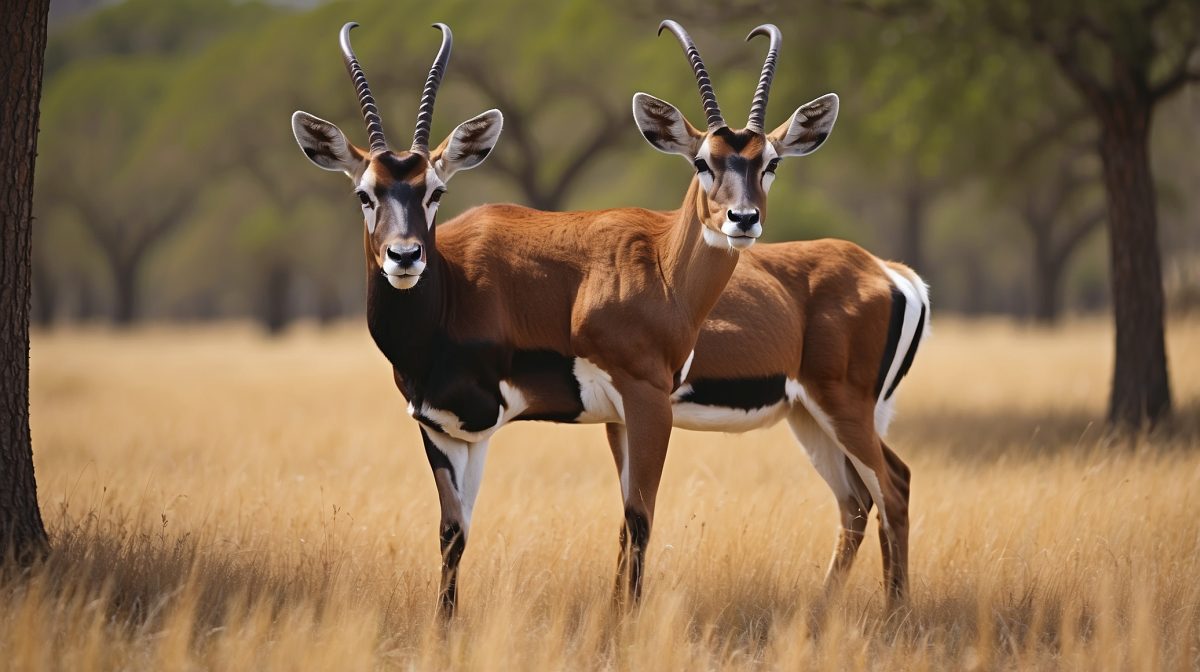A Brief History of Blackbuck Antelope
Origins in India
Let’s take a gander back to where it all started – the blackbuck antelope‘s native home, the Indian subcontinent. These critters have been roamin’ those lands for centuries, prancin’ through the grasslands and catchin’ the eyes of everyone with their impressive horns and swift moves. It’s no wonder folks over in Texas wanted to bring a piece of that exotic beauty to the Lone Star State.
The Introduction to Texas Soil
Now, how did these antelopes end up in Texas, you might ask? Well, back in the day, some folks with a vision for a grander kind of ranching decided to introduce these speedsters to our Texas soil. It was a move that brought a little bit of the wild Indian grasslands right here to our doorstep, and let me tell you, the blackbuck took to it like a cowboy to a rodeo.
Growth and Popularity in the Lone Star State
Once the blackbuck got their hooves on Texas ground, they started flourishin’ more than a field of wildflowers in springtime. They became a symbol of pride and joy for exotic ranchers and hunters alike, growin’ in numbers and popularity faster than a prairie fire with a tailwind. It wasn’t long ‘fore they were as much a part of Texas as longhorns and oil wells.
Blackbuck Habitats and Biology
Adaptations to the Texas Climate
Y’all might be wonderin’ how these critters from halfway ’round the world managed to settle in so nicely. Well, turns out, the Texas Hill Country is a fair bit like their native habitat – hot, dry, and just the right kind of rugged. These antelopes adapted quicker than a two-step at a honky-tonk, findin’ the climate here to their likin’ and thrivin’ in the process.
Diet and Behavior
Blackbucks are grazers, spendin’ their days munchin’ on the grasses and plants that our Texas landscape provides. They’re social animals, livin’ in herds, and you can often spot ’em leapin’ and gallivantin’ around, showin’ off for one another. It’s a sight to see, let me tell ya, and a true testament to the vibrancy of life they’ve brought to our state.
Reproduction and Lifespan
These antelopes don’t just look pretty; they’re also mighty fine at keepin’ their population healthy and strong. With a lifespan of ’bout 12 to 15 years in the wild, they’re prolific breeders, ensuring that there’s always a new generation of blackbuck to carry on their legacy here in Texas.
Conservation and Hunting Ethics
Role in Texas Ecosystems
The blackbuck antelope might not be native to Texas, but they’ve become an integrated part of our ecosystems. They fill a niche in our environment, and with careful management, they contribute to the biodiversity without displacin’ other local wildlife. It’s a delicate balance, but one that Texans have taken to heart in the spirit of conservation.
Conservation Measures
Conservation ain’t just a buzzword ’round these parts; it’s a way of life. Ranchers and wildlife experts work together to ensure that blackbuck populations are sustainable and healthy. From habitat management to breeding programs, every step is taken with the utmost respect for these creatures and the land they roam.
Hunting Regulations and Contributions to Conservation
Huntin’ blackbuck, like any game in Texas, is regulated to ensure ethical practices and conservation. Hunters play a pivotal role in this system, with their licensing fees and the controlled harvests helpin’ to fund conservation efforts and maintain healthy blackbuck populations. It’s a partnership between man and nature that benefits both.
The JL Bar Ranch Resort Experience
Blackbuck Hunting as a Tradition
Down at the JL Bar Ranch Resort, blackbuck huntin’ is more than just a sport – it’s a tradition steeped in Texas pride. Guests come from all over to experience the thrill of the hunt in a landscape that’s as wild and free as the blackbuck themselves. It’s a piece of Texan heritage that we’re proud to share.
The Expertise of Guides
When you set out on a hunt at the JL Bar Ranch, you’re not just wanderin’ the wilds hopin’ for a glimpse of antelope. You’re bein’ led by guides who know these lands like the back of their hands. They’re experts in trackin’, behavior, and the finer points of huntin’, ensurin’ that your experience is both successful and respectful to the game.
The Thrill of the Hunt
There’s somethin’ ’bout the chase, the strategy, and the patience of huntin’ that gets the heart pumpin’. And when you’re pursuin’ a creature as elegant and swift as the blackbuck, that thrill is amplified tenfold. It’s a dance between hunter and hunted, a respectful nod to the primal roots that connect us all.
The Cultural Impact of Blackbuck in Texas
Integration into Local Communities
Blackbuck antelope have become more than just animals in Texas; they’ve woven themselves into the fabric of our local communities. They’re a symbol of the exotic appeal of our ranches and the spirit of the wild that Texans hold dear. It’s a relationship that’s grown over time, built on mutual respect and admiration.
Economic Contributions
The presence of blackbuck in Texas isn’t just good for the soul; it’s good for the wallet too. The business of huntin’, ranchin’, and wildlife tourism has provided a hefty boost to our local economies. It’s a win-win, with folks gettin’ to experience the majesty of these creatures while supportin’ the livelihoods of those who make it possible.
Educational Opportunities
And let’s not forget the educational side of things. The blackbuck antelope offer a unique opportunity for folks, especially the young’uns, to learn about wildlife management, conservation, and the importance of biodiversity. Schools and organizations often visit ranches to see these animals up close, gainin’ knowledge that’ll last a lifetime.
Conclusion
As we wrap up this journey through the history and life of the blackbuck antelope in Texas, it’s clear these creatures are more than just another species in our great state. They’re a testament to Texas’ rich tradition of wildlife management and conservation. From the open plains of India to the sprawling ranges of the Texas Hill Country, the blackbuck’s story is one of resilience and adaptability. Now, let’s mosey on down to some questions y’all might still have.
FAQs
Why were blackbuck antelope brought to Texas in the first place?
Blackbuck antelope were brought to Texas for exotic game ranching and to add diversity to the wildlife population for hunting and conservation.
Are blackbuck antelopes considered invasive in Texas?
While blackbuck are non-native, they are not typically considered invasive due to careful management which prevents them from disrupting local ecosystems.
How does hunting blackbuck contribute to conservation efforts?
Hunting blackbuck contributes to conservation through regulated harvests, funding for wildlife management, and maintaining balanced populations.
Can you see blackbuck antelope in the wild in Texas, or only on ranches?
Blackbuck antelope are primarily found on private ranches in Texas, though they may occasionally be spotted in the wild within fenced properties.
What should someone expect when going on a blackbuck hunt at the JL Bar Ranch Resort?
Expect a guided experience with professional hunters, a challenging and ethical hunt, and a chance to engage with the beauty of the Texas Hill Country.


